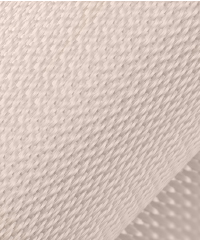In addition to welding protection, fiberglass fabrics are used in various fire work and thermal or acoustic insulation. The coating provides improved desired properties such as wear resistance, fire resistance and metal splash resistance.
The heat resistance of the uncoated fiberglass fabric is +550°C. Uncoated fabric is the economical option, but the wear resistance is poor as well as the material when handling dust.
Silicone-coated (S) fiberglass fabric is commonly used outdoor fire protection. The silicone coating has good weather resistance and is very resistant to ozone, UV light and aging. The coating is water repellent and impermeable to water vapor. Silicone is a halogen-free flame retardant material. Coating temperature resistance +250°C.
Aluminum coated (AL) fiberglass fabric is commonly used for thermal insulation of piping and other objects because the coating reflects heat radiation well. Coating temperature resistance +180°C.
The polyurethane coating (PU) contains aluminum particles that improve the heat reflectivity of the fabric once the polyurethane evaporates at higher temperatures. When melted, the aluminum particles forms an effective fire barrier on the surface of the fabric and extends the life of the fabric. Polyurethane begins to decompose at temperatures above +90°C. Polyurethane is a cost-effective coating and, in addition to fire resistance, improves the workability of the material and reduces dusting. Temperature resistance +550°C.
The calcium silicate coating (CS) melts on the surface of the fabric as a protective layer at high temperatures and improves the heat resistance of the base material (+550°C) up to +700°C in continuous use and +750°C in short-term use. The treatment also increases the wear resistance of the fabric. The material has good insulating properties and low smoke emission.
The vermiculite coating (FH) melts on the surface of the fabric as a protective layer at high temperatures and significantly improves the heat resistance (+550°C) of the base material up to +1000°C (short-term). The treatment also increases the wear resistance of the fabric. The material has good insulating properties, low smoke emission and withstands hot metal splashes and welding sparks. A more economical alternative to silica fabric, especially if better strength is required at higher temperatures.
We store fiberglass fabrics with base material thicknesses of 200g/m², 430g/m², 660g/m² and 1000g/m². The thicknesses of the materials are about 0.25mm, 0.5mm, 0.7mm and 1.3mm, respectively. The best-selling products are 660g/m² PU2 and 1000g/m² FH.
All coatings are available on one or both sides of the fabric. For example, the abbreviation AL1 means that the fabric is coated on one side with aluminum and PU2 means the fabric is coated on both sides with polyurethane.
If needed, uncoated fabrics can also be dyed, eg pink (LR) and coatings are available in different colors, eg red silicone.



